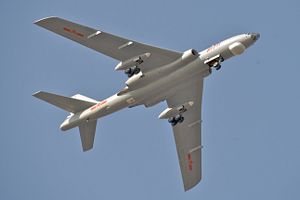On Monday, China’s air force held its first exercise in western Pacific Ocean airspace. As reported by the South China Morning Post, the People’s Liberation Army Air Force (PLAAF) carried out drills in the air over the Bashi Channel, the body of water between Taiwan and the Philippines archipelago, considered the rim of the first island chain. The purpose of the exercise was to boost the PLAAF’s capability to carry out far-sea operations.
Little is known about the specifics of the exercise. Colonel Shen Jinke, the PLAAF spokesperson who was quoted by a Chinese military news outlet, gave little information about the number of aircraft involved or specific types. The PLA Daily‘s English-language article on the exercise was accompanied by pictures of PLAAF “new-type” strategic bombers, suggesting the exercise could have had a strategic bombing focus.
“Training in the airspace far from China is an effective way for the PLA Air Force to temper its combat capability and also a common practice of world powers’ air forces,” said Col Shen, according to the PLA Daily. To assuage concerns from neighboring states, the report notes that “this training by the PLA Air Force complies with relevant international laws and practices, is not aimed at any country or target and poses no threat to any country or region.”
The exercise is indicative of China’s interest in preparing its military branches for expeditionary and far-sea operations. Traditionally, the People’s Liberation Army has been an insular military force, primarily concerned with the defense of China’s territory from external threats. However, with China’s rise and growing strategic interests in Asia’s near seas, the PLA has focused its efforts on expeditionary readiness. The PLAAF’s recent exercise is but a step in realizing a robust expeditionary capability.
The United States is concerned about the modernization of China’s air force. Last year, the Pentagon’s annual report described the modernization of the PLAAF as “unprecedented in history,” suggesting that China is heavily investing into its air power. “The PLAAF is pursuing modernization on a scale unprecedented in its history and is rapidly closing the gap with Western air forces across a broad spectrum of capabilities including aircraft, command and control (C2), jammers, electronic warfare (EW), and data links,” the Pentagon said in that report.
Other signs of the PLAAF’s growing prominence within the Chinese military include the accession of senior PLAAF airmen into prominent all-PLA leadership roles. Senior PLAAF officers, such as Xu Qiliang, have even ascended to the level of the Central Military Commission, China’s apex military body.
Despite these trends and U.S. acknowledgments of China’s growing air power capabilities, most strategists in the United States continue to read China’s military modernization by focusing on its anti-access/area-denial capabilities (A2/AD). To be sure, China’s A2/AD implementation, as it is perceived by the West, sidelines air power. Air power’s role is more crucial in a protracted conflict across the Taiwan strait.
The exercise is also a reminder that China’s air power extends beyond its immediate borders. Given recent comments by U.S. military leaders calling for joint ASEAN patrols in the South China Sea (and even Japanese air patrols in the region), China has good reason to remind observers of the PLAAF’s reach and capability.

































